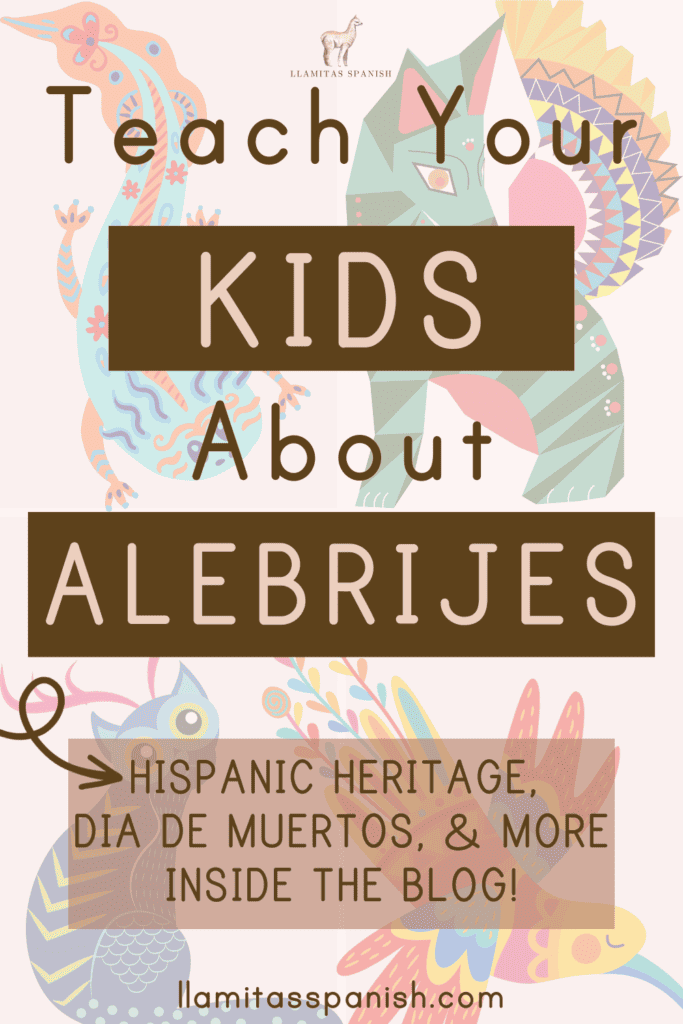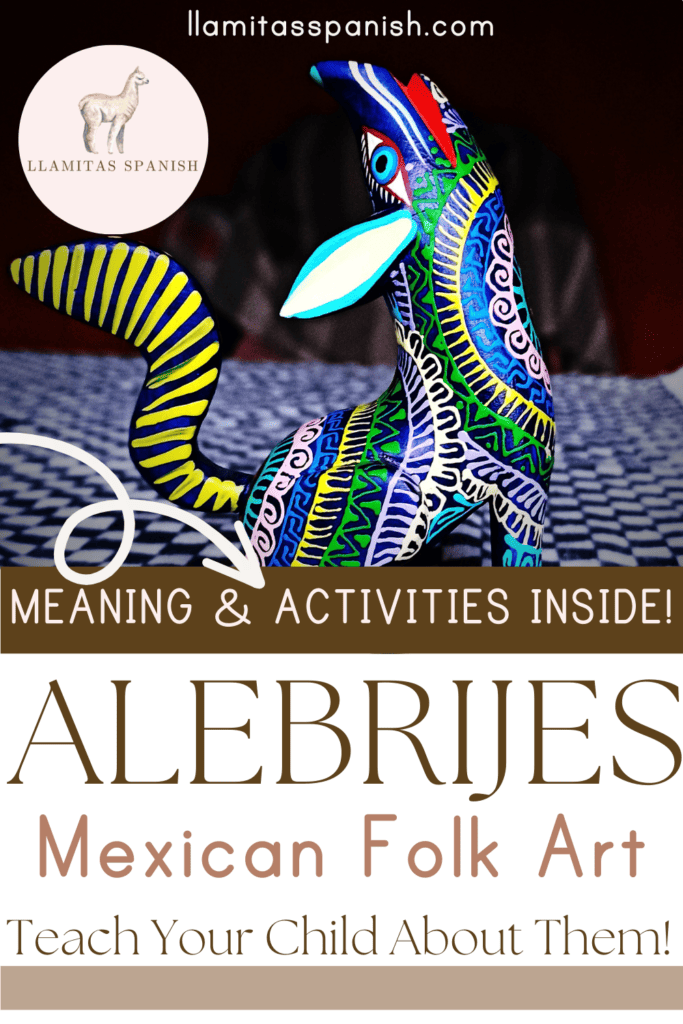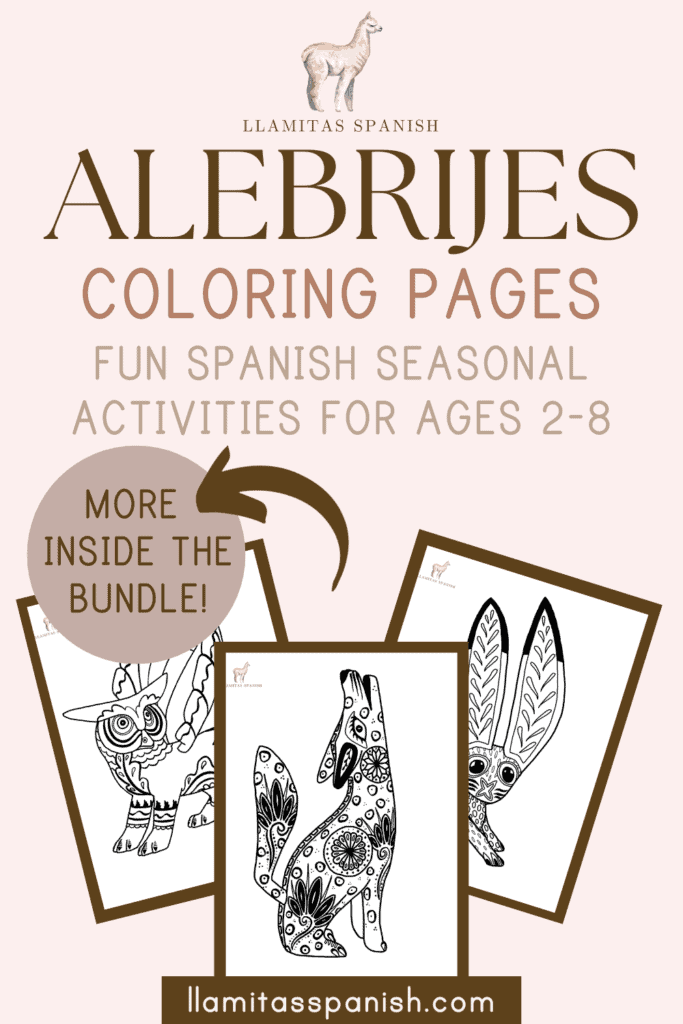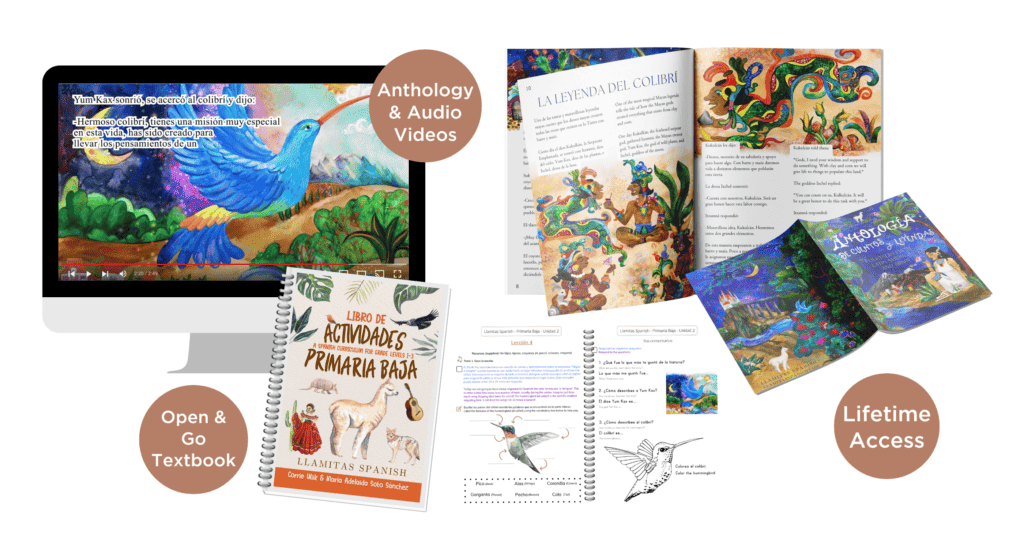In this post: Teach your kids about alebrijes—a famous type of Mexican folk art—with our Llamitas Spanish® Seasonal Bundle.
You may have heard that learning a foreign language goes hand-in-hand with learning about the culture, traditions, and history behind the language. But why?
Not only does understanding culture provide students with important context that can help them to understand the language better, but it also promotes empathy and helps us to raise global citizens.
At Llamitas Spanish®, we believe that learning language through the lens of culture is absolutely necessary, which is why our Spanish lessons are rooted in Hispanic culture.

Teaching your kids about alebrijes is a great way to enrich your homeschool Spanish lessons and learn more about Mexican art, culture, and history! These colorful sculptures are wildly popular and may have already already caught your eye on the shelves at stores, or in the Disney movie Coco.
Find out everything you need to know about alebrijes right here, along with some fun resources that you can use in your Spanish lessons.
Table of Contents
What are Alebrijes?
Alebrijes are Mexican folk art sculptures of vibrantly colored mythical creatures. You’ll also hear the term alebrijes referring to these fantastical creatures themselves.
Originally, alebrijes were made from papier-mâché, but today you can commonly find alebrije sculptures made from wood, cardboard, or paper.
The sculptures can depict any type of creature that the artist imagines. While some may depict realistic animals with colorful designs, others may combine various traits, such as horns or wings, from different animals and mythical creatures to create something new entirely. The only limit is the artist’s imagination.
Many people wonder where the word for these sculptures comes from. So, what does alebrije mean?
Well, there’s actually no direct translation for alebrijes in English. Just like the magical, mythical creatures themselves, the word was created specifically for this style of Mexican folk art.
The correct pronunciation of alebrije is ah-leh-bree-heh.
Related post: Latin American and Spanish Folktales for Kids
What’s the Meaning Behind Alebrijes?
Mexican alebrijes are often mistakenly believed to have a long history in traditional Mexican art and culture. But this type of artwork actually originated in the 1940s, making it relatively new in the grand scheme of things.

The History of Alebrijes
Pedro Linares, a well-known cartonería (papier-mâché artist) from Mexico City, is often credited as the original creator of alebrijes.
As the story goes, Linares fell extremely ill in 1943 and dreamed about strange and otherworldly animals, which were shouting, “¡Alebrije!” This dream is believed to have been the inspiration for the very first alebrijes that Linares created.
Although Linares was already a successful artist at the time, alebrijes really caught on when artists Frida Kahlo and Diego Rivera discovered his work.
You may also sometimes hear these sculptures referred to as “Oaxacan alebrijes.” That’s because Manuel Jiménez Ramírez, a sculptor from the Mexican state of Oaxaca in southern Mexico, helped to popularize alebrijes.
Inspired by Linares’ work, Ramírez used his own technique to carve alebrijes out of wood, a style that continues to be popular with alebrije sculptors.
Why are alebrijes important?
Alebrijes are one of the most famous styles of folk art from Mexico. Their popularity alone makes them culturally significant, but the meaning behind them is also important.
While we know that the original idea of alebrijes came from the artist’s fever dream, their significance evolved as they grew in popularity. Now, alebrijes are often seen as Mexican spirit animals.
A tradition of several Mesoamerican cultures, it was believed that each person had a spirit animal that would guide them through life. Each animal is tied to a different trait, such as strength (armadillo), loyalty (dog), or even a beautiful singing voice (bird).
The colors chosen for the alebrijes’ intricate designs are meaningful as well. For example, green is often associated with nature, pink with love, red with power, and so on.
Related post: Top 25 Famous Hispanic and Latino Artists You Should Know
Alebrijes in Disney’s Coco
Part of alebrijes’ current rise in popularity in the US may have something to do with the alebrijes in Disney’s Coco. The movie brings alebrijes to life for kids in a really fun and magical way—as can be expected with Disney!
While the focus of Coco is on Día de Muertos, alebrijes aren’t traditionally connected with the holiday. Still, the movie does a fantastic job incorporating important aspects of Mexican culture into the film, including its use of alebrijes.
In the movie, the alebrijes are a kind of spiritual guide for lost souls in the Land of the Dead. Two important alebrije characters in Coco are Dante and Pepita.
Dante begins the movie as Miguel’s adopted dog and goofy sidekick. Eventually, when Dante helps rescue Miguel and Héctor, Miguel realizes that he’s his real spirit guide and has been all along. At this point, Dante transforms into a colorful alebrije with awkward wings that appear a bit too small.
Pepita is a combination of several animals, including a jaguar and an eagle. While in the Land of the Living, however, Pepita takes on the form of a house cat. Pepita is Imelda’s spirit guide. She’s strong and protective, just like Imelda, and is able to track down Miguel throughout the movie, coming to his rescue more than once.
Related post: How to Watch Disney Plus in Spanish
Alebrijes Coloring Pages
If you’re looking for fun activities for teaching your kids about alebrijes, our Seasonal Bundle has you covered!
The bundle includes 7 Llamitas Spanish® seasonal units, perfect for practicing Spanish and learning about Hispanic culture through holiday-themed lessons.
Designed for kids ages 2–8, the seasonal bundle has everything you need, including printable activities, flashcards, cultural magazines, music playlists, and more.
Holidays included in the seasonal bundle are:
- Día de Muertos (Day of the Dead)
- Halloween
- Día de Acción de Gracias (Thanksgiving)
- La Navidad (Christmas)
- Día de San Valentín (Valentine’s Day)
- La Pascua (Easter)
- El Mes de la Herencia Hispana con Frida Kahlo (Hispanic Heritage Month)
Our Día de Muertos unit teaches kids about the celebrations and traditions behind this Mexican holiday. In this unit, they’ll also be able to learn more about alebrijes and make some of their very own with our coloring pages.
Related post: Día de Muertos Lesson and Activities for Kids
Llamitas Spanish® Curriculum
At Llamitas Spanish®, we aim to give you everything you need to successfully teach Spanish to your kids. But we want to go beyond simply teaching vocabulary and grammar, by immersing students in culture, too.
That’s why our authentic lessons are rooted in Spanish and Latin American music, art, history, and stories!
Raising your kids to be bilingual can seem daunting, but it doesn’t have to be hard—especially if you have the right resources. Our curriculum was designed to support bilingual families looking for an authentic and culturally rich learning experience.
Whether you’re learning Spanish alongside your child OR are a bilingual family looking for support in providing Spanish language input at home, our Llamitas Spanish® Curriculum is a completely done-for-you program.
With Spanish and English scripts, native speaker audio, thematic lessons, and fun activities, you won’t need anything else for your homeschool Spanish lessons.
We’ll do the planning and provide you with all the tools you need to teach your kids Spanish at home. All you have to do is open and go!


